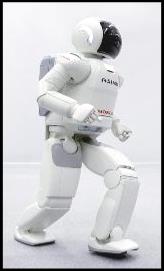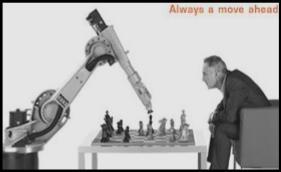|
Course description: The term Robot was first introduced by a Czech playwright Kerel Kapek in 1920. A robot is a programmable, multifunctional device designed to perform a verity of tasks including material handling, assembling, space exploration, servicing, welding, grinding and so on. Robotics has applications in space systems, medical surgery, industrial manufacturing, military and automotive systems. This course is concerned with developing and analyzing mathematical methods for modeling and control of unconstrained robotic systems. Topics to be covered consist of:
Modeling and Identification of Rigid Manipulators: Rigid motions and homogeneous transformations, Velocity kinematics and Jacobians, redundancy, Dynamics modeling: Background on dynamics Virtual decomposition method, Euler-Lagrange method, Background on Control of Nonlinear Systems: Lyapunov stability, Passivity, perturbed systems, Joint and Task-space Motion Control: State feedback: PD, Robust and Adaptive control, Friction compensation, Output feedback: Velocity and acceleration estimators, Motion control without velocity measurement*, Motion control including actuator dynamics, Control of flexible joint manipulators*, Introduction to Force-Motion Control ___________________________________________________________________ Grading: Robotic lab: 20% Mid-term exam: 30% Final exam: 50% ___________________________________________________________________ ___________________________________________________________________ References: 1. Theory of robot control, C. Canudas de Wit, B. Sicilliano and G. Bastin, Springer, 1996 2. Robot modeling and control, M. Spong, S. Hutchinson and M. Vidyasagar, John Wiley and sons, 2006, (SEE) 3. Fundamentals of robotic mechanical systems: Theory, methods and algorithms, J. Angeles, Springer, 2003, 4. Modeling and control of robot manipulators, L. Sciavicol and B. Sicilliano, McGraw Hill, 1996 5. Introduction to Robotics: Mechanics and Control, (3rd edition), John J. Craig, 2003 6. Nonlinear systems, H. Khalil, Prentice Hall, 1996 7. Nonlinear and adaptive control design, M. Krestic, I. Kanellakopoulos, P. Kokotovic, John Wiley and sons, 1995 |

|
New ASIMO humanoid of HONDA
|

|
Canadarm2 mounted on the International Space Station (ISS)
|




|
Control systems are ubiquitous |
|
Sharif university of technology Department of electrical engineering Digital systems group/Robotics
|

|
Robot Control 1 25-451, Fall 2019 Credits: 3 Level: Graduate, elective Prerequisite: Linear control systems Hours: Sunday, Tuesday, 3:00-4:30pm Location: B8 |
